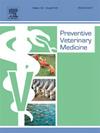Time to death for on-farm emergency slaughtered cattle in Norway
IF 2.4
2区 农林科学
Q1 VETERINARY SCIENCES
引用次数: 0
Abstract
Animal welfare and aspects of sustainability are growing concerns in cattle production. In Norway, on-farm emergency slaughter (OFES) accounts for 4.2% of all cattle slaughter. The time animals must wait for killing after veterinary inspection is an important, but unstudied, measure when considering the welfare of animals undergoing OFES. This study investigated 2229 cases of OFES from three regions in Norway. The Norwegian Food Safety Authority gave permission to collect data from physical handwritten OFES certificates collected and stored in each slaughterhouse from four months in 2018. The time from OFES certification to death could be calculated for 2028 cases. Survival analysis was used to investigate the hazard of death from OFES certification. Half of all cases were killed within 2.5 hours of OFES certification. The condition reported as the reason for OFES significantly affected time from OFES certification to death. Cattle reported to have obstetrical conditions were killed faster than cattle reported to be recumbent (Hazard Ratio 1.74, 95% CI 1.50-2.00). When considering the animal welfare implications of OFES, the length of time an animal is waiting to be killed is critical. The majority (75%) of cases in this study were killed within 4.25 hours, but the last 5% waited over 20 hours. This implies that some case selection is employed by personnel involved in the on-farm emergency slaughter process. This study provides information about the time cattle wait for OFES in Norway to allow for evidence-based, rather than anecdotal, discussions about the practice.
挪威农场紧急屠宰牛的死亡时间
在养牛生产中,动物福利和可持续性问题日益受到关注。在挪威,农场紧急屠宰(OFES)占所有牛屠宰量的4.2%。在考虑接受OFES的动物福利时,动物在兽医检查后等待宰杀的时间是一个重要但未经研究的衡量标准。本研究调查了挪威三个地区的2229例OFES病例。挪威食品安全局(Norwegian Food Safety Authority)允许从2018年4个月内收集并存储在每个屠宰场的实物手写OFES证书中收集数据。从OFES认证到死亡的时间可以计算为2028例。生存分析用于调查OFES认证的死亡危害。所有病例中有一半在OFES认证后2.5小时内死亡。报告的OFES原因严重影响了从获得OFES认证到死亡的时间。报告有产科状况的牛比报告躺卧的牛被更快地杀死(风险比1.74,95% CI 1.50-2.00)。当考虑到OFES对动物福利的影响时,动物等待被杀死的时间长度是至关重要的。在这项研究中,大多数(75%)病例在4.25小时内死亡,但最后5%的病例等待了20多个小时。这意味着一些病例选择是由参与农场紧急屠宰过程的人员进行的。这项研究提供了关于挪威牛等待OFES的时间的信息,以便对这种做法进行基于证据而不是轶事的讨论。
本文章由计算机程序翻译,如有差异,请以英文原文为准。
求助全文
约1分钟内获得全文
求助全文
来源期刊

Preventive veterinary medicine
农林科学-兽医学
CiteScore
5.60
自引率
7.70%
发文量
184
审稿时长
3 months
期刊介绍:
Preventive Veterinary Medicine is one of the leading international resources for scientific reports on animal health programs and preventive veterinary medicine. The journal follows the guidelines for standardizing and strengthening the reporting of biomedical research which are available from the CONSORT, MOOSE, PRISMA, REFLECT, STARD, and STROBE statements. The journal focuses on:
Epidemiology of health events relevant to domestic and wild animals;
Economic impacts of epidemic and endemic animal and zoonotic diseases;
Latest methods and approaches in veterinary epidemiology;
Disease and infection control or eradication measures;
The "One Health" concept and the relationships between veterinary medicine, human health, animal-production systems, and the environment;
Development of new techniques in surveillance systems and diagnosis;
Evaluation and control of diseases in animal populations.
 求助内容:
求助内容: 应助结果提醒方式:
应助结果提醒方式:


